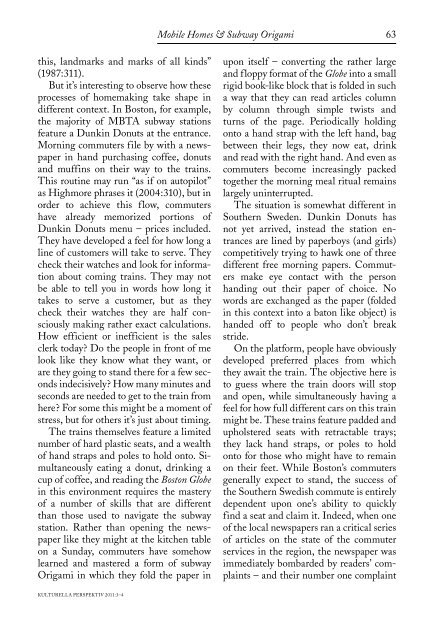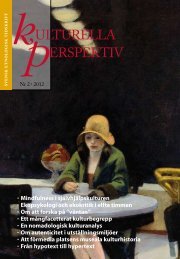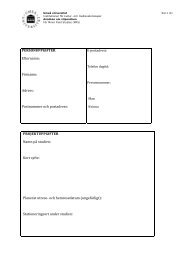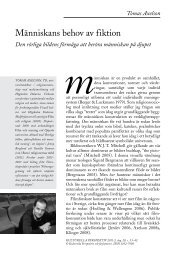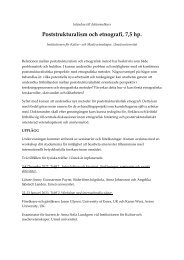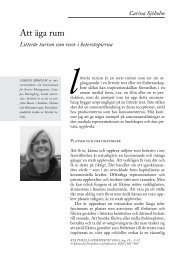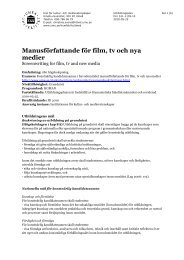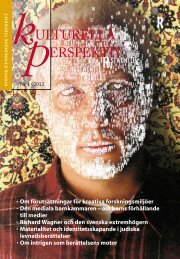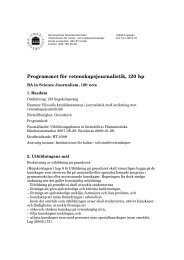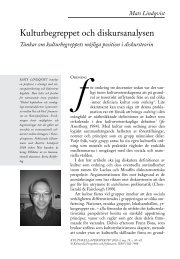Läs hela nr. 3-4 här - Institutionen för kultur och medievetenskaper
Läs hela nr. 3-4 här - Institutionen för kultur och medievetenskaper
Läs hela nr. 3-4 här - Institutionen för kultur och medievetenskaper
You also want an ePaper? Increase the reach of your titles
YUMPU automatically turns print PDFs into web optimized ePapers that Google loves.
Mobile Homes & Subway Origami<br />
63<br />
this, landmarks and marks of all kinds”<br />
(1987:311).<br />
But it’s interesting to observe how these<br />
processes of homemaking take shape in<br />
different context. In Boston, for example,<br />
the majority of MBTA subway stations<br />
feature a Dunkin Donuts at the entrance.<br />
Morning commuters file by with a newspaper<br />
in hand purchasing coffee, donuts<br />
and muffins on their way to the trains.<br />
This routine may run “as if on autopilot”<br />
as Highmore phrases it (2004:310), but in<br />
order to achieve this flow, commuters<br />
have already memorized portions of<br />
Dunkin Donuts menu – prices included.<br />
They have developed a feel for how long a<br />
line of customers will take to serve. They<br />
check their watches and look for information<br />
about coming trains. They may not<br />
be able to tell you in words how long it<br />
takes to serve a customer, but as they<br />
check their watches they are half consciously<br />
making rather exact calculations.<br />
How efficient or inefficient is the sales<br />
clerk today Do the people in front of me<br />
look like they know what they want, or<br />
are they going to stand there for a few seconds<br />
indecisively How many minutes and<br />
seconds are needed to get to the train from<br />
here For some this might be a moment of<br />
stress, but for others it’s just about timing.<br />
The trains themselves feature a limited<br />
number of hard plastic seats, and a wealth<br />
of hand straps and poles to hold onto. Simultaneously<br />
eating a donut, drinking a<br />
cup of coffee, and reading the Boston Globe<br />
in this environment requires the mastery<br />
of a number of skills that are different<br />
than those used to navigate the subway<br />
station. Rather than opening the newspaper<br />
like they might at the kitchen table<br />
on a Sunday, commuters have somehow<br />
learned and mastered a form of subway<br />
Origami in which they fold the paper in<br />
upon itself – converting the rather large<br />
and floppy format of the Globe into a small<br />
rigid book-like block that is folded in such<br />
a way that they can read articles column<br />
by column through simple twists and<br />
turns of the page. Periodically holding<br />
onto a hand strap with the left hand, bag<br />
between their legs, they now eat, drink<br />
and read with the right hand. And even as<br />
commuters become increasingly packed<br />
together the morning meal ritual remains<br />
largely uninterrupted.<br />
The situation is somewhat different in<br />
Southern Sweden. Dunkin Donuts has<br />
not yet arrived, instead the station entrances<br />
are lined by paperboys (and girls)<br />
competitively trying to hawk one of three<br />
different free morning papers. Commuters<br />
make eye contact with the person<br />
handing out their paper of choice. No<br />
words are exchanged as the paper (folded<br />
in this context into a baton like object) is<br />
handed off to people who don’t break<br />
stride.<br />
On the platform, people have obviously<br />
developed preferred places from which<br />
they await the train. The objective here is<br />
to guess where the train doors will stop<br />
and open, while simultaneously having a<br />
feel for how full different cars on this train<br />
might be. These trains feature padded and<br />
upholstered seats with retractable trays;<br />
they lack hand straps, or poles to hold<br />
onto for those who might have to remain<br />
on their feet. While Boston’s commuters<br />
generally expect to stand, the success of<br />
the Southern Swedish commute is entirely<br />
dependent upon one’s ability to quickly<br />
find a seat and claim it. Indeed, when one<br />
of the local newspapers ran a critical series<br />
of articles on the state of the commuter<br />
services in the region, the newspaper was<br />
immediately bombarded by readers’ complaints<br />
– and their number one complaint<br />
KULTURELLA PERSPEKTIV 2011:3–4


